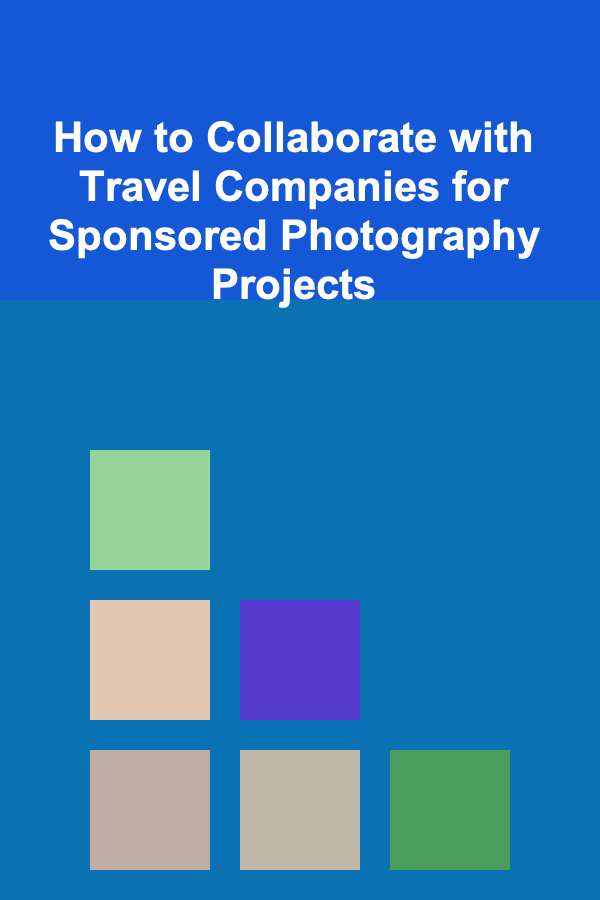
How to Collaborate with Travel Companies for Sponsored Photography Projects
ebook include PDF & Audio bundle (Micro Guide)
$12.99$6.99
Limited Time Offer! Order within the next:

Collaborating with travel companies for sponsored photography projects offers a unique opportunity to create stunning content while benefiting from brand exposure, compensation, and valuable experiences. Whether you are a seasoned photographer or a beginner looking to break into the world of travel photography, understanding the steps to successfully partner with travel companies can lead to mutually beneficial outcomes.
This actionable guide will take you through the process of collaborating with travel companies for sponsored photography projects, from initial research to post-project deliverables. By the end of this article, you'll have a comprehensive understanding of how to establish meaningful partnerships with travel companies, elevate your portfolio, and create content that resonates with your audience and their customers.
Research and Identify Potential Travel Companies
The first step in collaborating with travel companies is identifying the right ones to approach. Not all travel companies are looking for photography collaborations, so it's essential to align with brands whose objectives and style resonate with your work. Below are key aspects to consider when selecting potential companies:
Understand Their Brand and Audience
Start by researching travel companies whose brand, tone, and target audience align with your photographic style. For example:
- Luxury Travel Companies: If you specialize in high-end, cinematic photography, partner with luxury brands that cater to affluent travelers.
- Adventure Travel Brands: If you focus on action shots and outdoor exploration, look for companies that specialize in adventure travel experiences.
- Eco-Tourism Companies: If sustainability is important in your work, collaborate with eco-tourism companies that align with your values.
Look for Existing Collaborations
Investigate companies that have already worked with photographers or influencers. These collaborations might be advertised on social media, websites, or marketing materials, giving you insights into the type of content the company values.
Consider Location
Some travel companies may focus on specific destinations. Ensure that the places they cover are destinations where you can create high-quality photography that highlights the essence of the locations.
Evaluate Their Reputation
Before reaching out, ensure that the travel company has a good reputation in the industry. Research online reviews, past campaigns, and their social media presence to gauge their professional integrity and ability to deliver on commitments.
Develop Your Portfolio and Unique Selling Proposition (USP)
Travel companies are inundated with photographers vying for sponsored projects. To stand out, you need a portfolio that demonstrates not only your technical skill but also your unique perspective on travel and storytelling.
Create a Focused Travel Portfolio
Curate a travel-focused portfolio that showcases your best work from past trips or assignments. Highlight your ability to capture moments that resonate with the experiences people are seeking through travel, whether it's a serene landscape, a vibrant cultural scene, or the energy of adventure.
Establish Your Unique Style
Every photographer has a unique style, and it's essential to establish yours. Whether it's your editing techniques, the types of subjects you photograph, or the way you frame your shots, your style should stand out. Brands will be looking for photographers who can produce images that complement their own visual identity.
Highlight Your Social Proof
If you've worked with brands in the past, showcase those collaborations. A photographer with a proven track record will have an easier time securing future collaborations. Include any social media metrics, engagement data, or success stories to demonstrate the effectiveness of your previous work.
Build a Personal Brand
Establish a strong personal brand around travel photography. This could be through your blog, YouTube channel, Instagram, or other platforms where you share behind-the-scenes content, photography tips, or destination insights. A dedicated following can attract potential sponsors who see your ability to influence and inspire audiences.
Approach Travel Companies Effectively
Once you've identified the right travel companies and built a strong portfolio, it's time to reach out. Crafting a compelling proposal is key to securing a collaboration. Here's how to approach them:
Craft a Professional Email Pitch
When contacting a travel company, avoid generic messages. Tailor your pitch to each brand, showing that you understand their business and how your photography can contribute to their goals. Include:
- A Clear Subject Line: Make it direct and to the point, e.g., "Proposal for Sponsored Photography Collaboration".
- Introduction: Introduce yourself and your photography style, explaining why you're interested in working with them.
- Offer Value: Highlight what you can bring to the table. Whether it's stunning imagery for their marketing campaigns or exposure to your audience, show how your collaboration will benefit them.
- Portfolio Link: Include a link to your online portfolio or a specific project you think would resonate with their brand.
- Specific Proposal: Suggest how the collaboration could work. For example, you could offer to create photography for their new destination campaign, blog content, or Instagram posts.
- Follow-up: If you don't hear back within a week or two, send a polite follow-up email to reiterate your interest.
Create a Media Kit
For more serious inquiries, a media kit is a professional way to present your work. A media kit should include:
- A brief bio
- A portfolio or case studies of past collaborations
- Social media metrics (followers, engagement rate, audience demographics)
- Testimonials or client feedback
- A list of services you offer (e.g., photography, social media management, content creation)
Be Clear About Compensation
Travel companies may offer different compensation models, including monetary payment, free travel, or products. Be clear about your rates and the type of compensation you're looking for. If you are flexible, specify that as well.
Negotiate Terms and Define Deliverables
Once you've established interest from a travel company, the next step is to negotiate the terms of the collaboration. It's essential to have a clear agreement in place to avoid misunderstandings.
Define the Scope of Work
Clarify the expectations on both sides. What exactly are they looking for? Are they seeking photos for social media, website content, or print materials? Discuss how many photos you'll deliver, the deadlines, and the quality of the images.
Discuss Travel and Accommodation
If your collaboration requires travel, discuss the specifics regarding accommodations, transportation, and any other logistical details. Be sure to get clarity on what's covered by the brand and what you will need to arrange yourself.
Set Payment Terms
If the collaboration involves financial compensation, agree on payment terms. Will you be paid upfront, in installments, or upon completion? Get this in writing.
Establish Rights to the Photos
Clarify who will own the rights to the photos and whether you'll have the right to use them in your portfolio. Some brands may request exclusive usage rights, while others may allow you to share images on your personal platforms.
Execute the Project
With everything negotiated and agreed upon, it's time to execute the project. Here are some best practices to ensure that the collaboration goes smoothly:
Maintain Open Communication
Throughout the project, keep the brand updated on your progress. Ask for any feedback or specific requests they may have to ensure that the photos meet their expectations.
Be Adaptable
Travel and photography projects are dynamic. You may need to adapt to weather conditions, unexpected delays, or changes in plans. Stay flexible and be prepared to adjust your shots accordingly.
Capture Authentic Moments
Don't just focus on posed images---capture authentic, candid moments that resonate with the spirit of travel. Brands often prefer images that evoke a sense of wanderlust and authenticity.
Post-Project Follow-Up and Reporting
After the project is completed, it's important to follow up with the company and deliver the agreed-upon content. Provide them with all the photos in the specified formats and sizes.
Deliver Quality Content
Ensure that the images are edited professionally and delivered in the correct file formats (e.g., JPEG, TIFF) and sizes for web or print use.
Provide Analytics
If your collaboration involved social media promotion, provide analytics on the reach and engagement of the posts. This will help the brand understand the effectiveness of your collaboration and can pave the way for future projects.
Seek Feedback
Request feedback from the brand about the quality of the work, the results of the collaboration, and any areas for improvement. This information is invaluable for improving future projects.
Stay in Touch
Even after the project is over, stay in touch with the travel company. You never know when another opportunity may arise, and keeping the relationship alive is key to long-term success.
Conclusion
Collaborating with travel companies for sponsored photography projects is a rewarding way to advance your career while creating beautiful, engaging content. By doing your research, honing your portfolio, crafting a personalized pitch, and delivering high-quality work, you can build lasting relationships with travel brands and secure exciting projects.
Approach each collaboration with professionalism, creativity, and a focus on mutual benefit, and you'll be well on your way to becoming a sought-after photographer in the travel industry.
Other Products

How to Choose the Best Toys for Your Pet's Mental Stimulation
Read More
How to Keep Your Pet's Health in Check with Regular Home Care
Read More
How to Make Money Online as a LinkedIn Profile Writer: 10 Actionable Ideas
Read More
How to Maximize Natural Light in Your Living Space
Read More
How to Stay Financially Healthy During a Career Change
Read More